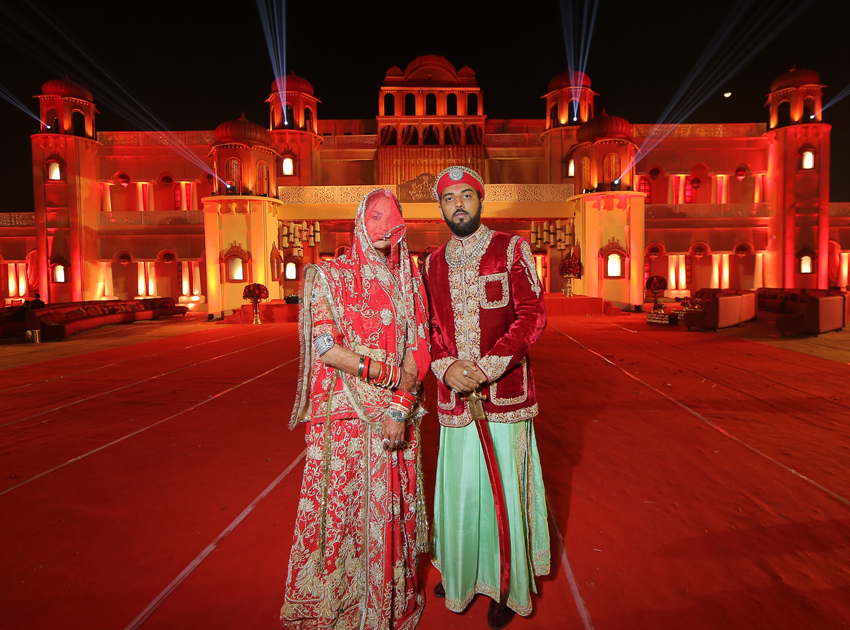
Eternal Mewar and An Eternal Wedding
Posted by Admin on Monday, February 17th, 2014
Of all the several hats (crowns in his case) that Shriji Arvind Singh Mewar wears, his most important in recent years is that of Cultural Conservationist. His Living Heritage project, whose core precept is ‘Continuity with Change’, has designed a functional blueprint and a living model of a community that practices and preserves the Mewari way of life while creatively matching step with a changing world. The project hinges on the position that the underlying principles of this heritage are not antiquated or regressive but enlightened, inclusive and in fact modern. Even eternal.
His son Lakshyaraj Singh Mewar’s recently concluded nuptials with Nivritti Kumari Deo were a sensitive testament of how to get that exactly right. How to match the outer symbols of heritage with inner principles.
Modern Indian weddings are a Bollywoodized version of heritage – a time when families reach far back into their cultural closets for every scrap of ‘tradition’ they can find. If their own are not spectacular enough, they will borrow a few. But while the zardozi on the bride’s sari is antique, the décolletage is emphatically not. The ceremony is pure sanatan, but abbreviated to suit short attention spans. Beautiful ‘traditional’ weddings that have been a year in the planning often barely even survive that long.
It’s easy to substitute form for substance. With swarms of cameras trained on the couple – their costumes, make-up and moves designed and choreographed by professionals - they feel like they are starring in their own real-life movie. There is a strong sense of make-believe. For them, for their supporting cast and for their audience guests, it’s easy to forget that a wedding is not just a week-long costume party.
The real substance of a marriage is a lot less glamorous . Aside from the rigours that a life-long committed relationship entails, a Hindu marriage stands for much more. It involves subsuming in some measure, your youthful individualism into social conformity. To submit yourself, in part at least, to the greater good – of family, community and tradition. To agree to not put yourself first.
For those who understand, all this is implicit in the mantras, pujas and rites that are performed, in the bowing to receive blessings, in the giving and receiving of gifts.
This understanding was in evidence at the Mewar wedding. It was there in the steely discipline of the tired bride weighed down by unaccustomed veils and jewelry as she sat steadfastly through puja after puja while guests grabbed some much needed rest. There again in the impeccable manners of the groom who greeted every guest by name and saw each one off when they left. And then again, when the newly-wed couple went to first pay their respects to the family-priest at his modest home before entering their own royal palace; walking up the narrow lane to his house even as crowds pushed cell-phone cameras into their faces. The wedding was as much about humility, patience and discipline as it was about royal splendour.
Every ceremony contrived to be accurate to the minutest Vedic detail. The archives and palace records were scoured to get everything exactly correct : right down to the very quantities of ghee, gur or rose petals to be used to worship the particular kul-devi or devta ; even the very kind of ghee or gur to be used.
There is method to this madness and meaning to the minutiae. The Living Heritage philosophy holds that rituals are intuitive of an underlying metaphysical principle. Outward alignment is an expression of inner alignment, each acting upon the other in a very real way. Besides, rituals being vehicles of culture, they must be preserved and practiced so that they survive into the future for coming generations to ponder, decode and draw from.
It’s certainly a difficult proposition. To be a king without political power, to be responsible for the survival of a kingdom that is an idea, not a geographic entity. To contextualize an ancient heritage to fit the 21st century. If it has been hard for Shriji Arvind Singh Mewar , it will be harder for his son. But a great vision , if underpinned by great integrity, has a power of it’s own.
Lakshyaraj Singh Mewar of Udaipur, Lakshyaraj Singh Mewar wedding
-
Shila Desai
-
Jenny Meade




